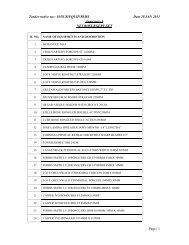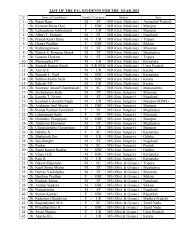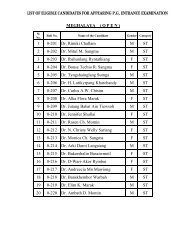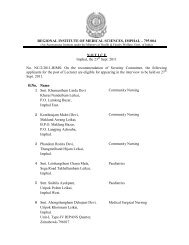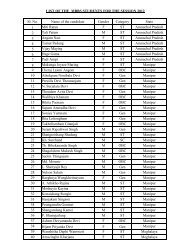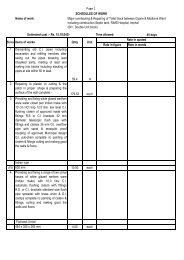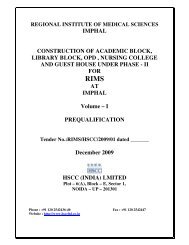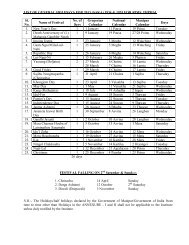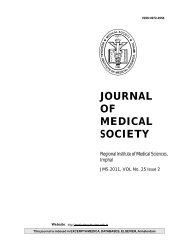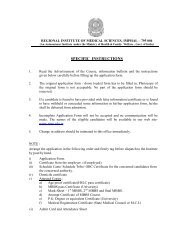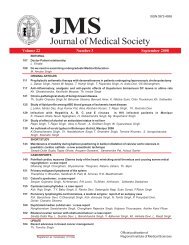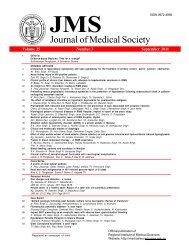Evidence-based Medicine: Time for a change? - Journal of Medical ...
Evidence-based Medicine: Time for a change? - Journal of Medical ...
Evidence-based Medicine: Time for a change? - Journal of Medical ...
Create successful ePaper yourself
Turn your PDF publications into a flip-book with our unique Google optimized e-Paper software.
ORIGINAL ARTICLE<br />
associated risk factors like HIV-HCV and HIV-<br />
HBV-HCV over and above alcoholic liver<br />
disease is an unique finding <strong>of</strong> this Northeastern<br />
state <strong>of</strong> India.<br />
There were 20 cases <strong>of</strong> HCC (15.15%)<br />
amongst the 132 CLD cases and 9 <strong>of</strong><br />
61(14.75%) chronic HCV. Out <strong>of</strong> the 20 HCC<br />
cases, 9 were associated with HCV (45%).<br />
Other associated risk factors found in these<br />
9 HCC cases were HIV-HCV (2 cases), HCV-<br />
HBV-HIV (1 case) and HCV cirrhosis with<br />
chronic alcoholic (6 cases). Other studies by<br />
Olubuyide et al in Ibadan, Kirk et al in West<br />
Africa and Kew in his study among blacks in<br />
Southern Africa found HCV infection in<br />
18.7%,19%, 13.2% and 19.5% <strong>of</strong> their<br />
patients with HCC respectively. 19,20,21 These<br />
studies show lower percentage <strong>of</strong> HCV<br />
associated HCC cases than the present<br />
study. However, Chen in his study among<br />
natives in Taiwan, found that 70-80% <strong>of</strong> his<br />
patients with HCC had evidence <strong>of</strong> HCV<br />
infection. 22 Similarly, Tanaka et al found that<br />
78% <strong>of</strong> Japanese patients with HCC had<br />
evidence <strong>of</strong> HCV infection. 23 The higher<br />
prevalence <strong>of</strong> HCV associated HCC (45%) in<br />
the present study may be because <strong>of</strong> high<br />
prevalence <strong>of</strong> IDU and sexually transmitted<br />
HIV which shares similar route <strong>of</strong><br />
transmission.<br />
Three (3) <strong>of</strong> the 11 cases (27.27%) <strong>of</strong> chronic<br />
HBV was found to be associated with HCC.<br />
In a prospective study conducted by Yang HI<br />
et al, the relative risk <strong>of</strong> HCC was 9.6 among<br />
men who were positive <strong>for</strong> HBsAg alone and<br />
60.2 among those who were positive <strong>for</strong> both<br />
HBsAg and HBeAg, as compared with men<br />
who were negative <strong>for</strong> both. 24 In the present<br />
study, 15% <strong>of</strong> the total HCC cases were<br />
associated with chronic HBV which include<br />
both HBeAg positive as well as negative<br />
cases. In Manipur AIDS Control Organisation<br />
report also, HBV coinfection with HIV is much<br />
lower than that <strong>of</strong> HCV though the real cause<br />
is not known so far.<br />
Four (4) <strong>of</strong> 67 chronic alcoholic cases (5.97%)<br />
were associated with HCC. Associated risk<br />
factors with chronic alcoholism were chronic<br />
smoking (46%), multiple sexual partner (36%),<br />
and occasional sexual relational relationship<br />
(20%)<br />
Presence <strong>of</strong> 31(23.48%) cases <strong>of</strong> HIV, HIV-<br />
HCV, HIV-HBV-HCV among 132 cases <strong>of</strong> CLD<br />
shows that there are multiple infections<br />
among CLD with or without HCC which can<br />
be an eye opener <strong>for</strong> the health care workers<br />
and the importance <strong>of</strong> prevention <strong>of</strong> these viral<br />
infections. Thus routine screening <strong>of</strong> HIV, HBV<br />
and HCV are important while managing CLD<br />
cases. The high prevalence <strong>of</strong> HCC amongst<br />
chronic HCV calls <strong>for</strong> the need <strong>of</strong> HCC<br />
screening among chronic HCV patients with<br />
nodular liver.<br />
Conclusion: The present study shows that<br />
the commonest risk factors <strong>for</strong> CLD are<br />
chronic alcoholism, (50.75%) and chronic<br />
HCV (46.21%). There were 20 (15.16%) cases<br />
<strong>of</strong> HCC. The most commonly associated risk<br />
factors <strong>for</strong> HCC are Chronic HCV (45%) with<br />
or without co-infection, chronic alcoholism<br />
(30%), etc.<br />
The limitations <strong>of</strong> the present study are small<br />
sample size, unvailability <strong>of</strong> facilities <strong>for</strong> HBV/<br />
HCV genotyping and viral load and liver biopsy.<br />
A larger study with adequate sample size is<br />
needed to give us more insight about the<br />
clinical pr<strong>of</strong>ile <strong>of</strong> Chronic liver disease with<br />
reference to hepatocellular Carcinoma in<br />
Manipur.<br />
Reference:<br />
1. Yu MH, Chang HC, Liaw YF, Lin SM, Lee<br />
SD, Liu CJ. Familial Risk <strong>of</strong><br />
Hepatocellular Carcinoma among<br />
Chronic Hepatitis B Carriers and Their<br />
Relatives. J natl cancer Inst 2000 Jul 19;<br />
92(14):1159.<br />
2. Sherlock S, Dooley J. Hepatic<br />
transplantation. In: Sherlock S, Dooley<br />
J, editors. Diseases <strong>of</strong> the liver and biliary<br />
system. 11 th ed. London: Blackwell<br />
Science; 2002. p. 657-76.<br />
3. Carr BI. Tumors <strong>of</strong> the biliary tree. In:<br />
Fauci AS, Kasper DL, Longo DL,<br />
Braunwald E, Hauser SL, Jameson JL,<br />
editors. Harrison’s principles <strong>of</strong> internal<br />
medicine. 17 th ed. New York: McGraw<br />
Hill; 2008. p. 581-82.<br />
18 JMS * JMS Vol 25 * Vol * No. 25 3 * No. * September, 1 * June, 2010 2011



